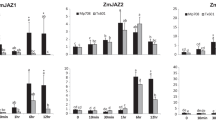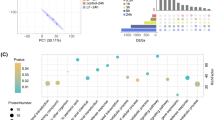Abstract
Key message
Silencing OsMPK3 decreased elicited JA levels, which subsequently reduced levels of herbivore-induced trypsin protease inhibitors (TrypPIs) and improved the performance of SSB larvae, but did not influence BPH.
Abstract
Mitogen-activated protein kinases (MPKs) are known to play an important role in plant defense by transferring biotic and abiotic signals into programmed cellular responses. However, their functions in the herbivore-induced defense response in rice remain largely unknown. Here, we identified a MPK3 gene from rice, OsMPK3, and found that its expression levels were up-regulated in response to infestation by the larvae of the striped stem borer (SSB) (Chilo suppressalis), to mechanical wounding and to treatment with jasmonic acid (JA), but not to infestation by the brown planthopper (BPH) Nilaparvata lugens or to treatment with salicylic acid. Moreover, mechanical wounding and SSB infestation induced the expression of OsMPK3 strongly and quickly, whereas JA treatment induced the gene more weakly and slowly. Silencing OsMPK3 (ir-mpk3) reduced the expression of the gene by 50–70 %, decreased elicited levels of JA and diminished the expression of a lipoxygenase gene OsHI-LOX and an allene oxide synthase gene OsAOS1. The reduced JA signaling in ir-mpk3 plants decreased the levels of herbivore-induced trypsin protease inhibitors (TrypPIs) and improved the performance of SSB larvae, but did not influence BPH. Our findings suggest that the gene OsMPK3 responds early in herbivore-induced defense and can be regulated by rice plants to activate a specific and appropriate defense response to different herbivores.




Similar content being viewed by others
Abbreviations
- JA:
-
Jasmonic acid
- SA:
-
Salicylic acid
- ET:
-
Ethylene
- MPK:
-
Mitogen-activated protein kinase
- MEKK:
-
MPK kinase kinase
- MEK:
-
MPK kinase
- WIPK:
-
Wound-induced protein kinase
- SIPK:
-
Salicylic acid-induced protein kinase
- TrypPIs:
-
Trypsin protease inhibitors
- SSB:
-
Striped stem borer
- BPH:
-
Brown planthopper
- WT:
-
Wild type
- qPCR:
-
Quantitative real-time PCR
References
Agrawal GK, Rakwal R, Iwahashi H (2002) Isolation of novel rice (Oryza sativa L.) multiple stress responsive MAP kinase gene, OsMSRMK2, whose mRNA accumulates rapidly in response to environmental cues. Biochem Biophys Res Commun 294:1009–1016
Asai T, Tena G, Plotnikova J, Willmann MR, Chiu WL, Gomez-Gomez L, Boller T, Ausubel FM, Sheen J (2002) MAP kinase signalling cascade in Arabidopsis innate immunity. Nature 415:977–983
Ballaré CL (2011) Jasmonate-induced defenses: a tale of intelligence, collaborators and rascals. Trends Plant Sci 16:249–257
Bostock RM (2005) Signal crosstalk and induced resistance: straddling the line between cost and benefit. Annu Rev Phytopathol 43:545–580
Brodersen P, Petersen M, Nielsen HB, Zhu SJ, Newman MA, Shokat KM, Rietz S, Parker J, Mundy J (2006) Arabidopsis MAP kinase 4 regulates salicylic acid- and jasmonic acid/ethylene-dependent responses via EDS1 and PAD4. Plant J 47:532–546
Browse J, Howe GA (2008) New weapons and a rapid response against insect attack. Plant Physiol 146:832–838
Chehab EW, Perea JV, Gopalan B, Theg S, Dehesh K (2007) Oxylipin pathway in rice and Arabidopsis. J Integr Plant Biol 49:43–51
Cheng JA, He J (1996) Rice insect pests. China Agricultural Press, Beijing
De Vleesschauwer D, Yang Y, Cruz CV, Hofte M (2010) Abscisic acid-induced resistance against the brown spot pathogen Cochliobolus miyabeanus in rice involves MAP kinase-mediated repression of ethylene signaling. Plant Physiol 152:2036–2052
Hamel LP, Nicole MC, Sritubtim S, Morency MJ, Ellis M, Ehlting J, Beaudoin N, Barbazuk B, Klessig D, Lee J, Martin G, Mundy J, Ohashi Y, Scheel D, Sheen J, Xing T, Zhang SQ, Seguin A, Ellis BE (2006) Ancient signals: comparative genomics of plant MAPK and MAPKK gene families. Trends Plant Sci 11:192–198
Han L, Li GJ, Yang KY, Mao G, Wang R, Liu Y, Zhang S (2010) Mitogen-activated protein kinase 3 and 6 regulate Botrytis cinerea-induced ethylene production in Arabidopsis. Plant J 64:114–127
Howe GA, Jander G (2008) Plant immunity to insect herbivores. Annu Rev Plant Biol 59:41–66
Huang HJ, Fu SF, Tai YH, Chou WC, Huang DD (2002) Expression of Oryza sativa MAP kinase gene is developmentally regulated and stress-responsive. Physiol Plant 114:572–580
Kandoth PK, Ranf S, Pancholi SS, Jayanty S, Walla MD, Miller W, Howe GA, Lincoln DE, Stratmann JW (2007) Tomato MAPKs LeMPK1, LeMPK2, and LeMPK3 function in the systemin-mediated defense response against herbivorous insects. Proc Natl Acad Sci USA 104:12205–12210
Kim CY, Zhang SQ (2004) Activation of a mitogen-activated protein kinase cascade induces WRKY family of transcription factors and defense genes in tobacco. Plant J 38:142–151
Kim CY, Liu YD, Thorne ET, Yang HP, Fukushige H, Gassmann W, Hildebrand D, Sharp RE, Zhang SQ (2003) Activation of a stress-responsive mitogen-activated protein kinase cascade induces the biosynthesis of ethylene in plants. Plant Cell 15:2707–2718
Kumar KRR, Srinivasan T, Kirti PB (2009) A mitogen-activated protein kinase gene, AhMPK3 of peanut: molecular cloning, genomic organization, and heterologous expression conferring resistance against Spodoptera litura in tobacco. Mol Genet Genomics 282:65–81
Li Q, Xie QG, Smith-Becker J, Navarre DA, Kaloshian I (2006) Mi-1-mediated aphid resistance involves salicylic acid and mitogen-activated protein kinase signaling cascades. Mol Plant Microbe Interact 19:655–664
Liu YK (2012) Roles of mitogen-activated protein kinase cascades in ABA signaling. Plant Cell Rep 31:1–12
Lou YG, Baldwin IT (2003) Manduca sexta recognition and resistance among allopolyploid Nicotiana host plants. Proc Natl Acad Sci USA 100(supplement 2):14581–14586
Lou YG, Du MH, Turlings TCJ, Cheng JA, Shan WF (2005a) Exogenous application of jasmonic acid induces volatile emissions in rice and enhances parasitism of Nilaparvata lugens eggs by the Parasitoid Anagrus nilaparvatae. J Chem Ecol 31:1985–2002
Lou YG, Ma B, Cheng JA (2005b) Attraction of the parasitoid Anagrus nilaparvatae to rice volatiles induced by the rice brown planthopper Nilaparvata lugens. J Chem Ecol 31:2357–2372
Lou Y, Hua X, Turlings TC, Cheng J, Chen X, Ye G (2006) Differences in induced volatile emissions among rice varieties result in differential attraction and parasitism of Nilaparvata lugens eggs by the parasitoid Anagrus nilaparvatae in the field. J Chem Ecol 32:2375–2387
Lu YJ, Wang X, Lou YG, Cheng JA (2006) Role of ethylene signaling in the production of rice volatiles induced by the rice brown planthopper Nilaparvata lugens. Chin Sci Bull 51:2457–2465
Lu J, Ju HP, Zhou GX, Zhu CS, Erb M, Wang XP, Wang P, Lou YG (2011) An EAR-motif-containing ERF transcription factor affects herbivore-induced signaling, defense and resistance in rice. Plant J 68:583–596
Meldau S, Wu JQ, Baldwin IT (2009) Silencing two herbivory-activated MAP kinases, SIPK and WIPK, does not increase Nicotiana attenuata’s susceptibility to herbivores in the glasshouse and in nature. New Phytol 181:161–173
Menke FLH, van Pelt JA, Pieterse CMJ, Klessig DF (2004) Silencing of the mitogen-activated protein kinase MPK6 compromises disease resistance in Arabidopsis. Plant Cell 16:897–907
Nakagami H, Pitzschke A, Hirt H (2005) Emerging MAP kinase pathways in plant stress signalling. Trends Plant Sci 10:339–346
Petersen M, Brodersen P, Naested H, Andreasson E, Lindhart U, Johansen B, Nielsen HB, Lacy M, Austin MJ, Parker JE, Sharma SB, Klessig DF, Martienssen R, Mattsson O, Jensen AB, Mundy J (2000) Arabidopsis MAP kinase 4 negatively regulates systemic acquired resistance. Cell 103:1111–1120
Qi JF, Zhou GX, Yang LJ, Erb M, Lu YH, Sun XL, Cheng JA, Lou YG (2011) The chloroplast-localized phospholipases D alpha4 and alpha5 regulate herbivore-induced direct and indirect defenses in rice. Plant Physiol 157:1987–1999
Qiu JL, Zhou L, Yun BW, Nielsen HB, Fiil BK, Petersen K, MacKinlay J, Loake GJ, Mundy J, Morris PC (2008) Arabidopsis mitogen-activated protein kinase kinases MKK1 and MKK2 have overlapping functions in defense signaling mediated by MEKK1, MPK4, and MKS1. Plant Physiol 148:212–222
Ren CM, Zhu Q, Gao BD, Ke SY, Yu WC, Xie DX, Peng W (2008) Transcription factor WRKY70 displays important but no indispensable roles in jasmonate and salicylic acid signaling. J Integr Plant Biol 50:630–637
Reyna NS, Yang YN (2006) Molecular analysis of the rice MAP kinase gene family in relation to Magnaporthe grisea infection. Mol Plant Microbe Interact 19:530–540
Riemann M, Riemann M, Takano M (2008) Rice JASMONATE RESISTANT 1 is involved in phytochrome and jasmonate signalling. Plant Cell Environ 31:783–792
Schäfer M, Fischer C, Meldau S, Seebald E, Oelmuller R, Baldwin IT (2011) Lipase activity in insect oral secretions mediates defense responses in Arabidopsis. Plant Physiol 156:1520–1534
Shen XL, Yuan B, Liu HB, Li XH, Xu CG, Wang SP (2010) Opposite functions of a rice mitogen-activated protein kinase during the process of resistance against Xanthomonas oryzae. Plant J 64:86–99
Song FM, Goodman RM (2002) OsBIMK1, a rice MAP kinase gene involved in disease resistance responses. Planta 215:997–1005
Suarez-Rodriguez MC, Petersen M, Mundy J (2010) Mitogen-activated protein kinase signaling in plants. Annu Rev Plant Biol 61:621–649
van Dam NM, Horn M, Mares M, Baldwin IT (2001) Ontogeny constrains systemic protease inhibitor response in Nicotiana attenuata. J Chem Ecol 27:547–568
Wang X, Zhou GX, Xiang CY, Du MH, Cheng JA, Liu SS, Lou YG (2008) β-Glucosidase treatment and infestation by the rice brown planthopper Nilaparvata lugens elicit similar signaling pathways in rice plants. Chin Sci Bull 53:53–57
Wang X, Hu LC, Zhou GX, Cheng JA, Lou YG (2011) Salicylic acid and ethylene signaling pathways are involved in production of rice trypsin protease inhibitors induced by the leaf folder Cnaphalocrocis medinalis (Guenée). Chin Sci Bull 56:2351–2358
Wen JQ, Oono K, Imai R (2002) Two novel mitogen-activated protein signaling components, OsMEK1 and OsMAP1, are involved in a moderate low-temperature signaling pathway in rice. Plant Physiol 129:1880–1891
Wu JQ, Baldwin IT (2010) New insights into plant responses to the attack from insect herbivores. Annu Rev Genet 44:1–24
Wu JQ, Hettenhausen C, Meldau S, Baldwin IT (2007) Herbivory rapidly activates MAPK signaling in attacked and unattacked leaf regions but not between leaves of Nicotiana attenuata. Plant Cell 19:1096–1122
Xiong LZ, Yang YN (2003) Disease resistance and abiotic stress tolerance in rice are inversely modulated by an abscisic acid-inducible mitogen-activated protein kinase. Plant Cell 15:745–759
Yeh CM, Hung WC, Huang HJ (2003) Copper treatment activates mitogen-activated protein kinase signalling in rice. Physiol Plant 119:392–399
Yoo SD, Cho YH, Tena G, Xiong Y, Sheen J (2008) Dual control of nuclear EIN3 by bifurcate MAPK cascades in C2H4 signalling. Nature 451:789–795
Yoshida S, Forno DA, Cock JH, Gomez KA (1976) Laboratory manual for physiological studies of rice. International Rice Research Institute, Los Baños
Yuan B, Shen X, Li X, Xu C, Wang SP (2007) Mitogen-activated protein kinase OsMPK6 negatively regulates rice disease resistance to bacterial pathogens. Planta 226:953–960
Zhou GX, Qi JF, Ren N, Cheng JA, Erb M, Mao BZ, Lou YG (2009) Silencing OsHI-LOX makes rice more susceptible to chewing herbivores, but enhances resistance to a phloem feeder. Plant J 60:638–648
Zhou GX, Wang X, Yan F, Li R, Cheng JA, Lou YG (2011) Genome-wide transcriptional changes and defence-related chemical profiling of rice in response to infestation by the rice striped stem borer Chilo suppressalis. Physiol Plant 143:21–40
Acknowledgments
We thank Guoxin Zhou for his invaluable assistance with the experiments, and Emily Wheeler for editorial assistance. This study was jointly sponsored by the National Basic Research Program of China (2010CB126200), the National Natural Science Foundation of China (30871644), the National Program of Transgenic Variety Development of China (2011ZX08001-001), and the China Agriculture Research System (CARS-01-21).
Author information
Authors and Affiliations
Corresponding author
Additional information
Communicated by M. Petersen.
A contribution to the Special Issue: Plant Hormone Signaling.
Electronic supplementary material
Below is the link to the electronic supplementary material.
Rights and permissions
About this article
Cite this article
Wang, Q., Li, J., Hu, L. et al. OsMPK3 positively regulates the JA signaling pathway and plant resistance to a chewing herbivore in rice. Plant Cell Rep 32, 1075–1084 (2013). https://doi.org/10.1007/s00299-013-1389-2
Received:
Revised:
Accepted:
Published:
Issue Date:
DOI: https://doi.org/10.1007/s00299-013-1389-2




